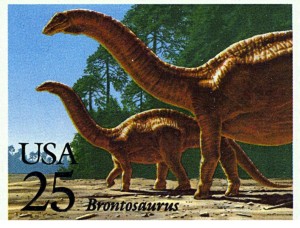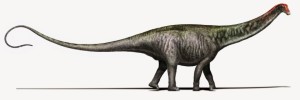Are We Calling Them Brontosauruses Again
Jurassic giant's taxonomic condition is restored.

The name Brontosaurus has endured in pop culture, such as this 1989 Us stamp. Credit: USPS
The Brontosaurus is back. Dinosaur fossils that were originally described every bit Brontosaurus excelsus in 1879 and after renamed should indeed be classified as Brontosaurus, a study of dozens of dinosaur specimens concludes.
That may not sit well with palaeontology aficionados, who dear to point out that Brontosaurus has not been a valid taxonomic name since the early twentieth century. (Simply ask the United states Postal Service, which was roundly criticized later on information technology released a Brontosaurus postage in 1989.)
The ascent, fall and now rise of the Brontosaurus has its roots in the 'bone wars' of nineteenth-century palaeontology. While some prospectors dug up the American Westward in search of mineral fortunes in the middle to late 1800s, others looked for giant lizards. A race between palaeontologists Edward Cope and Othniel Marsh defined the era.
"Cope and Marsh were big rivals," says Emanuel Tschopp, a palaeontologist at the Nova University of Lisbon, Portugal, who led the latest written report, published on seven Apr in the journal PeerJ 1. "They really rushed new species into press as fast equally possible, and many of these reference specimens on which they based new species are extremely fragmentary and are not comparable straight."
Working in Colorado's Morrison formation in 1877, Marsh'south field crew uncovered the gargantuan bones of a species he dubbed Apatosaurus ajax — a genus name that translates to deceptive lizard, and a species proper name that references the Greek hero Ajax. 2 years later, Marsh institute some other behemothic dinosaur in the same rock formation and named it Brontosaurus excelsus, the noble thunder lizard.
In the early 1900s, later discovering a fossil that was similar to both Brontosaurus and Apatosaurus, other researchers decided that the two dinosaurs were distinct species of the same genus. Subsequent studies simply raised further questions about the condition of Brontosaurus.
Palaeontologists somewhen agreed that Brontosaurus is properly called Apatosaurus, under taxonomic rules drafted by the eighteenth-century Swedish systematist Carl Linnaeus and still in employ today. The rules state that the offset proper noun given for an brute takes priority. The basic attributed to Brontosaurus excelsus, therefore, belonged to Apatosaurus excelsus.

The first known Brontosaurus fossil was unearthed in the Morrison formation in Colorado. Credit: Davide Bonadonna
Cartoon a family tree
Tschopp didn't ready out to resurrect the Brontosaurus when he started analysing unlike specimens of diplodocid — the group to which Apatosaurus, Diplodocus and other giants vest. But he was interested in reviewing how the fossils had been classified and whether anatomical differences between specimens represented variation within species, or between species or genera. Tschopp and his colleagues analysed nearly 500 anatomical traits in dozens of specimens belonging to all of the 20 or so species of diplodocids to create a family tree. They spent five years amassing data, visiting 20 museums across Europe and the The states.
Very broadly, their tree confirmed established ideas about the evolutionary relationships among diplodocids. But the scientists also concluded that Apatosaurus and Brontosaurus were different enough to vest in their own genera. Many of the anatomical differences between the two dinosaurs are obscure, Tschopp says, but Apatosaurus's stouter cervix is an obvious one. "Even though both are very robust and massive animals, Apatosaurus is even more so," he adds.
Tschopp and his team idea very carefully about their decision to reinstate Brontosaurus, and they expect some pushback. "We knew information technology would exist a major finding because Brontosaurus is such a popular name," he says. "I'thou pretty sure there volition be a scientific discussion around this. I promise there will exist. That'southward how scientific discipline works."
The resurrection of Brontosaurus may grab all the headlines, but the analysis too reshuffles some other dinosaurs. A species called Diplodocus hayi got its own genus, Galeamopus. Meanwhile, the squad determined that a dinosaur from Portugal called Dinheirosaurus belongs in the genus Supersaurus, remains of which have been found only in N America.
The proper name game
The paper represents "the all-time current view" of diplodocids, says Michael Benton, a vertebrate palaeontologist at the University of Bristol, UK. The traits that distinguish Brontosaurus from Apatosauru s are in line with characteristics that define other genera of sauropod, the larger dinosaur grouping to which diplodocids belong.
"The discrimination of Brontosaurus from Apatosaurus will exist startling," he says. "It's the classic example we e'er employ to explain the significant of 'synonym' to students, or as an case of the speed and dastardly deeds of Marsh and Cope as they each rushed to proper name new taxa, sometimes the aforementioned beast."
Philip Mannion, a palaeontologist at Imperial College London, says the written report is important not only for its resurrection of Brontosaurus. By determining which diplodocid bones fall under which species and genus, it should make it easier for palaeontologists to correctly classify new finds while helping them to understand the evolution of some of the largest dinosaurs that lived.
"The public is going to become a lot out of this considering Brontosaurus has this very prominent place in the public imagination," says Mannion, who has a personal stake in the issue.
Several years ago, he was contacted past a poster visitor asking whether Brontosauru s was a valid dinosaur name. "A father had bought a poster for his kid, and the kid straight away said Brontosaurus isn't a existent dinosaur," remembers Mannion, who told the company that the kid was correct.
Will Mannion now tell the firm that the Brontosaurus is back? "Peradventure I'll let them arrive touch on," he says.
References
Related links
Rights and permissions
Nigh this article
Cite this article
Callaway, E. Beloved Brontosaurus makes a comeback. Nature (2015). https://doi.org/10.1038/nature.2015.17257
-
Published:
-
DOI : https://doi.org/10.1038/nature.2015.17257
Source: https://www.nature.com/articles/nature.2015.17257
0 Response to "Are We Calling Them Brontosauruses Again"
Post a Comment